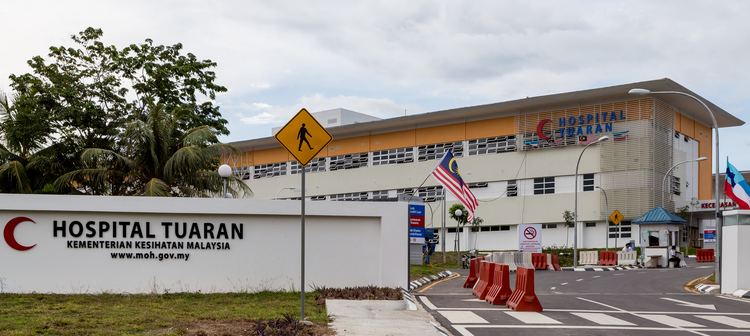Area 1,166 km² Local time Sunday 12:08 PM | Postcode 892XX Population 102,411 (2010) | |
 | ||
Website www.sabah.gov.my/pd.trn Weather 33°C, Wind N at 8 km/h, 63% Humidity | ||
Tuaran is a town and district 1,166 square kilometres in size, situated in West Coast Division, Sabah, Malaysia. The town is bordered on three sides by the eponymous river. It is located 34 kilometres (21 mi) north of the state capital Kota Kinabalu, and is strategically situated along the main highway linking Kota Kinabalu with the north of Sabah.
Contents
Map of Tuaran, Sabah, Malaysia
Etymology
The existence of Tuaran in colonial records can be traced as far back as 1813, in official letters written by Sir Stamford Raffles, the then British Governor of Java, seeking permission to accept the Sultan of Brunei's invitation to deal with piracy issues at 'Jawaran' in the north of Borneo.
'Jawaran' is a corruption of the Malay word tawaran. Tawaran has two meanings; the first meaning is 'fresh water', referring to the importance of the Tuaran area as a source of freshwater for the locality. The second meaning is 'to bargain', which refers to the trading activities which had been taking place in the Tuaran area even before British colonisation commenced in 1884.
Demography
In 2010, the population of Tuaran district was estimated at 102,411. Approximately half the population consists of ethnic Dusuns, mostly of the Lotud ethnic subgroup and a third are of Bajau descent. The remainder are mostly of the Malaysian Chinese community, particularly from the Hakka subgroup.
Bahar wine
The Dusun Lotud people of Tuaran produce a traditional liquor called bahar (toddy) made from coconut sap mixed with a kind of tree bark known locally as rosok which colours the sap red. Bahar has been scientifically proven to be rich in antioxidants. However, it is extremely pungent and spoils very quickly, usually within one day.
Tuaran mee
Tuaran mee (Traditional Chinese: 鬥亞蘭面; Hakka: Diu ah lan men), which literally translates as 'Tuaran noodles', is a noodle dish created by the Hakka Chinese community of Tuaran. The noodles are made from a batter consisting of egg yolk and flour. They are fried for five to ten minutes in high heat, causing the bottom part of the noodles to become crunchy. Local vegetables are added during frying. Before Tuaran mee is served, it is usually garnished with slices of sweetened Chinese roast pork (Traditional Chinese: 叉燒; Hakka: cha sau) and fried egg rolls (Traditional Chinese: 春捲; Hakka: chun kien).
Tamu
Every Sunday morning, a tamu (native open-air market) is held in Tuaran town. At the tamu, produce, seafood, handicrafts and other goods from Tuaran and the surrounding villages are bought and sold.
Tourism
Tourist attractions in Tuaran include the Mengkabong and Penimbawan water villages, which are villages of stilt houses built over the seashore by the Bajau people, and the Ling San Pagoda (Traditional Chinese: 龍山塔), a nine-storey Buddhist pagoda situated just outside the town centre.
The main tourist resorts in Tuaran are the Mimpian Jadi Resort and Shangri-La's Rasa Ria Resort. In addition to food and lodging, these resorts offer various other activities such as golfing and water sports.
